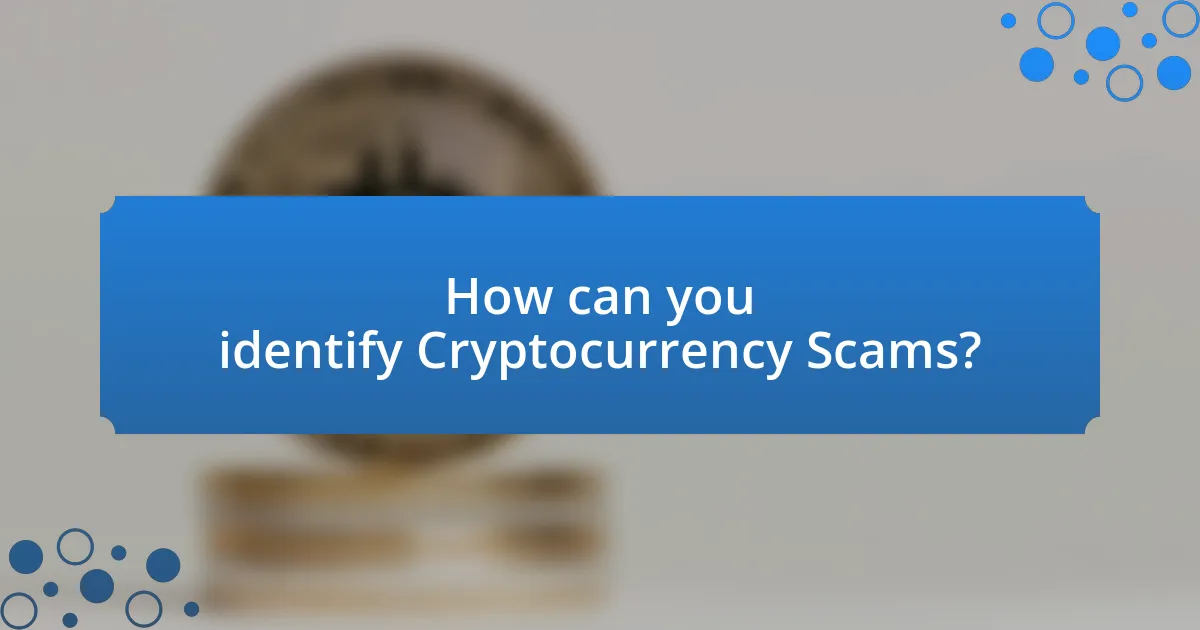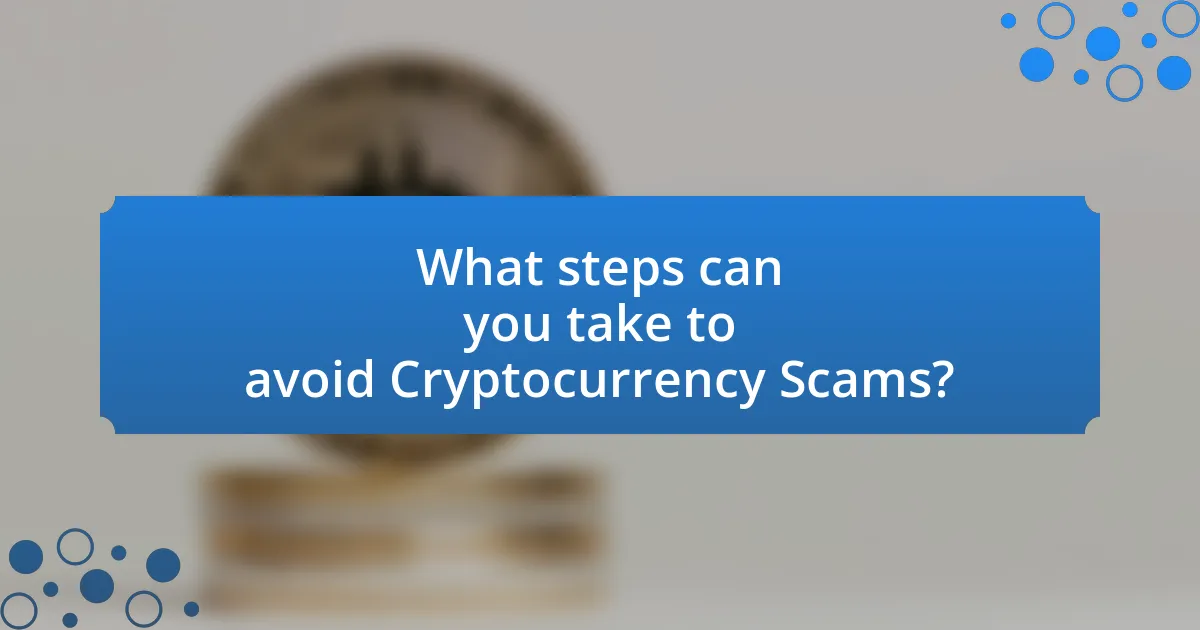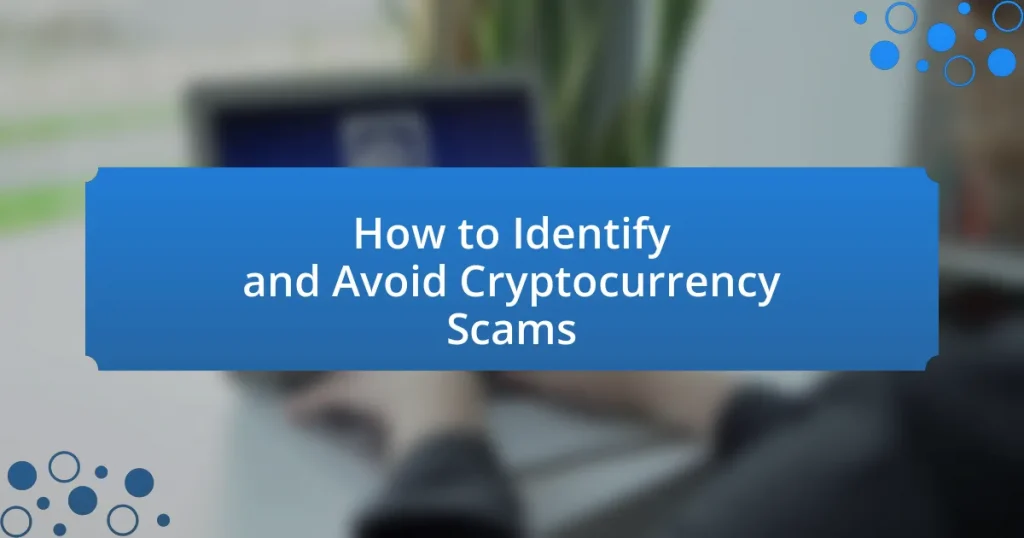Cryptocurrency scams are fraudulent schemes that exploit the popularity of digital currencies, leading to significant financial losses for individuals. These scams manifest in various forms, including Ponzi schemes, phishing attacks, and fake initial coin offerings (ICOs). The article outlines how these scams operate, the tactics used by scammers, and the common types of scams prevalent in the cryptocurrency space. It emphasizes the importance of identifying red flags, such as unrealistic promises and lack of transparency, and provides strategies for verifying the legitimacy of cryptocurrency projects. Additionally, it offers best practices for avoiding scams, protecting personal information, and utilizing available resources for reporting and education.

What are Cryptocurrency Scams?
Cryptocurrency scams are fraudulent schemes that exploit the popularity and complexity of digital currencies to deceive individuals into losing money. These scams can take various forms, including Ponzi schemes, phishing attacks, fake initial coin offerings (ICOs), and fraudulent exchanges. According to the Federal Trade Commission (FTC), consumers reported losing over $80 million to cryptocurrency scams in 2020 alone, highlighting the significant financial impact of these fraudulent activities.
How do Cryptocurrency Scams operate?
Cryptocurrency scams operate primarily through deceptive practices that exploit the lack of regulation and the anonymity of digital currencies. Scammers often create fake investment opportunities, promising high returns with little risk, and use social engineering tactics to manipulate victims into providing personal information or transferring funds. For instance, according to the Federal Trade Commission, consumers reported losing over $80 million to cryptocurrency scams in 2021 alone, highlighting the prevalence and effectiveness of these fraudulent schemes. Additionally, scams may involve phishing attacks, where attackers impersonate legitimate exchanges or wallets to steal credentials, or Ponzi schemes that pay returns to earlier investors using the capital from newer investors, ultimately collapsing when new investments dwindle.
What tactics do scammers use to deceive victims?
Scammers use various tactics to deceive victims, including impersonation, urgency, and manipulation of emotions. Impersonation involves pretending to be a trusted entity, such as a government agency or a well-known company, to gain the victim’s trust. Urgency tactics create a false sense of immediacy, pressuring victims to act quickly without fully considering the risks. Emotional manipulation often exploits fear or greed, enticing victims with promises of high returns or threats of loss. According to the Federal Trade Commission, consumers reported losing over $1.9 billion to fraud in 2021, highlighting the effectiveness of these tactics in deceiving individuals.
How can the psychology of fear and greed be exploited in scams?
Scammers exploit the psychology of fear and greed by creating high-pressure situations that manipulate individuals into making impulsive decisions. For instance, they often present urgent scenarios, such as limited-time investment opportunities, that trigger fear of missing out on potential profits. This tactic is evident in cryptocurrency scams, where victims are promised extraordinary returns, appealing to their greed. Research indicates that emotional responses significantly influence decision-making, with fear and greed being powerful motivators that can override rational thinking. Consequently, individuals may overlook warning signs and invest in fraudulent schemes, leading to financial loss.
What are the common types of Cryptocurrency Scams?
Common types of cryptocurrency scams include Ponzi schemes, phishing attacks, fake initial coin offerings (ICOs), and pump-and-dump schemes. Ponzi schemes promise high returns with little risk, using funds from new investors to pay earlier ones, which is unsustainable and illegal. Phishing attacks involve tricking individuals into providing sensitive information, often through fake websites or emails that appear legitimate. Fake ICOs present non-existent projects to lure investors, while pump-and-dump schemes artificially inflate the price of a cryptocurrency through misleading promotions, allowing scammers to sell at a profit before the price crashes. According to the Federal Trade Commission, consumers lost over $80 million to cryptocurrency scams in 2020, highlighting the prevalence and impact of these fraudulent activities.
What is a Ponzi scheme in the context of cryptocurrency?
A Ponzi scheme in the context of cryptocurrency is a fraudulent investment scam that promises high returns with little risk to investors, relying on the influx of new investors to pay returns to earlier investors. This scheme typically involves a cryptocurrency project that lacks a legitimate business model or revenue generation, instead using funds from new participants to provide returns to existing ones, creating an illusion of profitability. Historical examples, such as BitConnect, illustrate how these schemes can attract significant investment before collapsing when new investor funds dwindle, leaving many participants with substantial losses.
How do phishing scams target cryptocurrency users?
Phishing scams target cryptocurrency users by impersonating legitimate services to steal sensitive information such as private keys and login credentials. These scams often utilize fake websites, emails, or messages that closely resemble those of reputable cryptocurrency exchanges or wallets, tricking users into providing their personal data. According to a report by the Anti-Phishing Working Group, phishing attacks have increased significantly, with cryptocurrency-related phishing incidents rising by 40% in 2021 alone. This demonstrates the effectiveness of phishing tactics in exploiting the growing interest in cryptocurrencies.

How can you identify Cryptocurrency Scams?
You can identify cryptocurrency scams by looking for red flags such as promises of guaranteed returns, lack of transparency, and pressure to invest quickly. Scammers often use high-pressure tactics to create a sense of urgency, claiming that an investment opportunity is time-sensitive. Additionally, legitimate projects typically provide clear information about their team, technology, and business model, while scams often lack detailed documentation or have anonymous teams. According to the Federal Trade Commission, consumers reported losing over $80 million to cryptocurrency scams in 2021, highlighting the prevalence of these fraudulent schemes.
What red flags should you look for in cryptocurrency offers?
Red flags to look for in cryptocurrency offers include promises of guaranteed returns, lack of transparency, and pressure to invest quickly. Offers that guarantee high returns with little risk are often indicative of scams, as legitimate investments carry inherent risks. Additionally, if the offer lacks clear information about the team behind the project or the technology used, it raises concerns about credibility. Pressure tactics, such as limited-time offers or urgency to invest, are common in fraudulent schemes, as they aim to prevent thorough research. According to the Federal Trade Commission, consumers reported losing over $80 million to cryptocurrency scams in 2021, highlighting the importance of vigilance in identifying these warning signs.
How can unrealistic promises indicate a scam?
Unrealistic promises can indicate a scam by suggesting that the offer is too good to be true, often involving guaranteed high returns with little to no risk. Scammers frequently exploit this tactic to lure individuals into investing by creating an illusion of easy wealth, which is not supported by legitimate market behavior. For instance, according to the U.S. Securities and Exchange Commission, investment opportunities that promise high returns with minimal risk are often fraudulent, as legitimate investments carry inherent risks. This pattern of unrealistic claims serves as a red flag, signaling potential deceit and urging individuals to conduct thorough research before engaging with such offers.
What role does lack of transparency play in identifying scams?
Lack of transparency significantly hinders the identification of scams by obscuring critical information about the legitimacy of operations and intentions. When organizations or individuals do not disclose their practices, financial data, or operational details, it becomes challenging for potential victims to assess the risk involved. For instance, a study by the Federal Trade Commission in 2021 revealed that 80% of reported cryptocurrency scams involved platforms that provided little to no information about their operations, leading to increased victimization. This lack of clarity allows scammers to exploit trust and manipulate perceptions, making it essential for individuals to seek transparent information before engaging in any financial transactions.
How can you verify the legitimacy of a cryptocurrency project?
To verify the legitimacy of a cryptocurrency project, conduct thorough research on its team, technology, and community engagement. Start by examining the project’s whitepaper, which should clearly outline its purpose, technology, and roadmap. A legitimate project typically has a transparent team with verifiable identities and relevant experience in the blockchain industry. Additionally, check for active community engagement on platforms like GitHub, Telegram, or Reddit, where developers and users discuss updates and issues.
Furthermore, assess the project’s partnerships and collaborations with reputable companies or organizations, as these can indicate credibility. Look for independent audits of the project’s code by recognized firms, which can provide assurance of its security and functionality. Finally, review the project’s history for any red flags, such as previous scams or legal issues, to gauge its reliability.
What tools and resources are available for research?
Various tools and resources are available for research on identifying and avoiding cryptocurrency scams. Key resources include blockchain explorers like Etherscan and Blockchair, which allow users to track transactions and verify the legitimacy of wallets. Additionally, websites such as CoinMarketCap and CoinGecko provide comprehensive data on cryptocurrency prices, market capitalization, and historical performance, aiding in the assessment of a cryptocurrency’s credibility. Furthermore, forums like Reddit and specialized groups on Telegram or Discord can offer community insights and warnings about potential scams. Research papers, such as “Cryptocurrency Scams: A Study of the Risks and Prevention Strategies” published in the Journal of Financial Crime, provide academic perspectives on the subject, reinforcing the importance of thorough research before engaging in cryptocurrency transactions.
How can community feedback help in assessing legitimacy?
Community feedback can significantly aid in assessing legitimacy by providing real-time insights and experiences from users. When individuals share their experiences with a cryptocurrency project, it creates a collective knowledge base that can highlight potential red flags or confirm the project’s authenticity. For instance, platforms like Reddit and specialized forums often feature discussions where users report scams or endorse legitimate projects, allowing others to gauge the credibility of a cryptocurrency based on community sentiment. This communal vetting process is crucial, as studies show that user reviews and feedback can influence perceptions of trustworthiness, with 79% of consumers trusting online reviews as much as personal recommendations. Thus, community feedback serves as a vital tool in identifying and avoiding scams in the cryptocurrency space.

What steps can you take to avoid Cryptocurrency Scams?
To avoid cryptocurrency scams, conduct thorough research on any investment opportunity before committing funds. This includes verifying the legitimacy of the cryptocurrency project, checking for regulatory compliance, and reviewing the team behind the project. According to the Federal Trade Commission, consumers lost over $80 million to cryptocurrency scams in 2020, highlighting the importance of due diligence. Additionally, utilize reputable exchanges and wallets, enable two-factor authentication, and be wary of unsolicited offers or pressure tactics, as these are common red flags associated with scams.
How can you protect your personal information?
To protect your personal information, use strong, unique passwords for each account and enable two-factor authentication whenever possible. Strong passwords should include a mix of letters, numbers, and symbols, making them harder to guess. According to a study by the National Institute of Standards and Technology, using two-factor authentication can reduce the risk of unauthorized access by 99.9%. Additionally, be cautious about sharing personal information online and regularly review privacy settings on social media platforms to limit exposure.
What security measures should you implement for your accounts?
To secure your accounts, implement strong, unique passwords, enable two-factor authentication (2FA), and regularly monitor account activity. Strong passwords should be at least 12 characters long, combining letters, numbers, and symbols, as studies show that complex passwords significantly reduce the risk of unauthorized access. Two-factor authentication adds an extra layer of security by requiring a second form of verification, which can decrease the likelihood of account breaches by up to 99%. Regularly monitoring account activity allows for the early detection of suspicious transactions, which is crucial in preventing financial loss, especially in the context of cryptocurrency scams where rapid action can mitigate damage.
How can you recognize and avoid phishing attempts?
To recognize and avoid phishing attempts, individuals should look for suspicious email addresses, poor grammar, and urgent requests for personal information. Phishing emails often come from addresses that mimic legitimate sources but contain slight variations, such as misspellings. Additionally, these emails frequently contain grammatical errors and spelling mistakes, which can indicate a lack of professionalism. Urgent calls to action, such as threats of account suspension or promises of rewards, are also common tactics used by phishers to create panic and prompt hasty decisions. According to the Anti-Phishing Working Group, in 2022, over 1.5 million phishing sites were reported, highlighting the prevalence of these scams. To avoid falling victim, users should verify the sender’s identity, refrain from clicking on suspicious links, and use two-factor authentication for added security.
What best practices should you follow when investing in cryptocurrency?
When investing in cryptocurrency, best practices include conducting thorough research, diversifying investments, using secure wallets, and being cautious of scams. Conducting thorough research involves understanding the technology, market trends, and the specific cryptocurrencies being considered, which helps in making informed decisions. Diversifying investments reduces risk by spreading capital across multiple assets rather than concentrating it in one. Using secure wallets, such as hardware wallets, protects assets from hacks and theft, as they store private keys offline. Being cautious of scams is crucial; investors should be wary of promises of guaranteed returns and should verify the legitimacy of projects and exchanges before investing. According to a report by the Federal Trade Commission, consumers lost over $80 million to cryptocurrency scams in 2020, highlighting the importance of vigilance in this area.
How can diversification reduce the risk of scams?
Diversification can reduce the risk of scams by spreading investments across various assets, which minimizes the impact of a single fraudulent scheme. When individuals allocate their funds into multiple cryptocurrencies or investment vehicles, they decrease the likelihood of losing their entire investment to one scam. For instance, if an investor puts all their money into a single cryptocurrency that turns out to be a scam, they face total loss. However, if they diversify their portfolio, the potential loss from one asset is mitigated by the performance of others. Historical data shows that diversified portfolios tend to have lower volatility and risk, as evidenced by studies from financial institutions like Vanguard, which indicate that diversification can lead to more stable returns over time.
What role does skepticism play in safe investing?
Skepticism plays a crucial role in safe investing by encouraging investors to critically evaluate opportunities and claims before committing funds. This critical assessment helps to identify potential scams, particularly in the volatile cryptocurrency market, where fraudulent schemes are prevalent. For instance, a 2021 report by the Federal Trade Commission revealed that consumers lost over $80 million to cryptocurrency scams, highlighting the necessity of skepticism in protecting investments. By questioning the legitimacy of investment opportunities and conducting thorough research, investors can mitigate risks and avoid falling victim to deceptive practices.
What resources are available for reporting and educating about scams?
Resources available for reporting and educating about scams include government agencies, non-profit organizations, and online platforms. The Federal Trade Commission (FTC) provides a dedicated website for reporting scams and offers educational materials on how to recognize and avoid them. Additionally, the Better Business Bureau (BBB) offers resources for reporting scams and consumer education. Websites like Scamwatch and the Internet Crime Complaint Center (IC3) also serve as platforms for reporting scams and provide information on various types of fraud. These resources are validated by their established roles in consumer protection and fraud prevention, making them reliable for individuals seeking assistance and education on scams.
How can you report a cryptocurrency scam effectively?
To report a cryptocurrency scam effectively, you should gather all relevant information, including transaction details, communication records, and any identifying information about the scammer. Then, report the scam to your local law enforcement agency, as they can investigate and take appropriate action. Additionally, you should report the scam to the platform where the scam occurred, such as a cryptocurrency exchange or social media site, as they may have procedures in place to handle such incidents. Furthermore, filing a complaint with consumer protection agencies, such as the Federal Trade Commission (FTC) in the United States, can help raise awareness and potentially prevent others from falling victim to the same scam.
What educational resources can help you stay informed about scams?
Educational resources that can help you stay informed about scams include government websites, consumer protection organizations, and online educational platforms. For instance, the Federal Trade Commission (FTC) provides comprehensive information on various types of scams, including cryptocurrency scams, through its website, which is regularly updated with the latest data and alerts. Additionally, organizations like the Better Business Bureau (BBB) offer resources and reports on scams affecting consumers. Online platforms such as Coursera and Udemy also offer courses focused on cybersecurity and fraud prevention, which can enhance your understanding of how to identify and avoid scams. These resources are credible and provide factual information that can help individuals recognize and protect themselves against fraudulent activities.
What are the key takeaways for avoiding Cryptocurrency Scams?
To avoid cryptocurrency scams, individuals should conduct thorough research, verify the legitimacy of platforms, and be cautious of unrealistic promises. Researching involves checking for regulatory compliance and reading reviews from credible sources. Verifying legitimacy includes ensuring that the platform is registered with relevant authorities, such as the Financial Crimes Enforcement Network (FinCEN) in the U.S. Additionally, being cautious of offers that guarantee high returns with little risk is crucial, as these are common red flags in scams. According to the Federal Trade Commission (FTC), consumers lost over $80 million to cryptocurrency scams in 2021, highlighting the importance of vigilance and skepticism in cryptocurrency investments.


